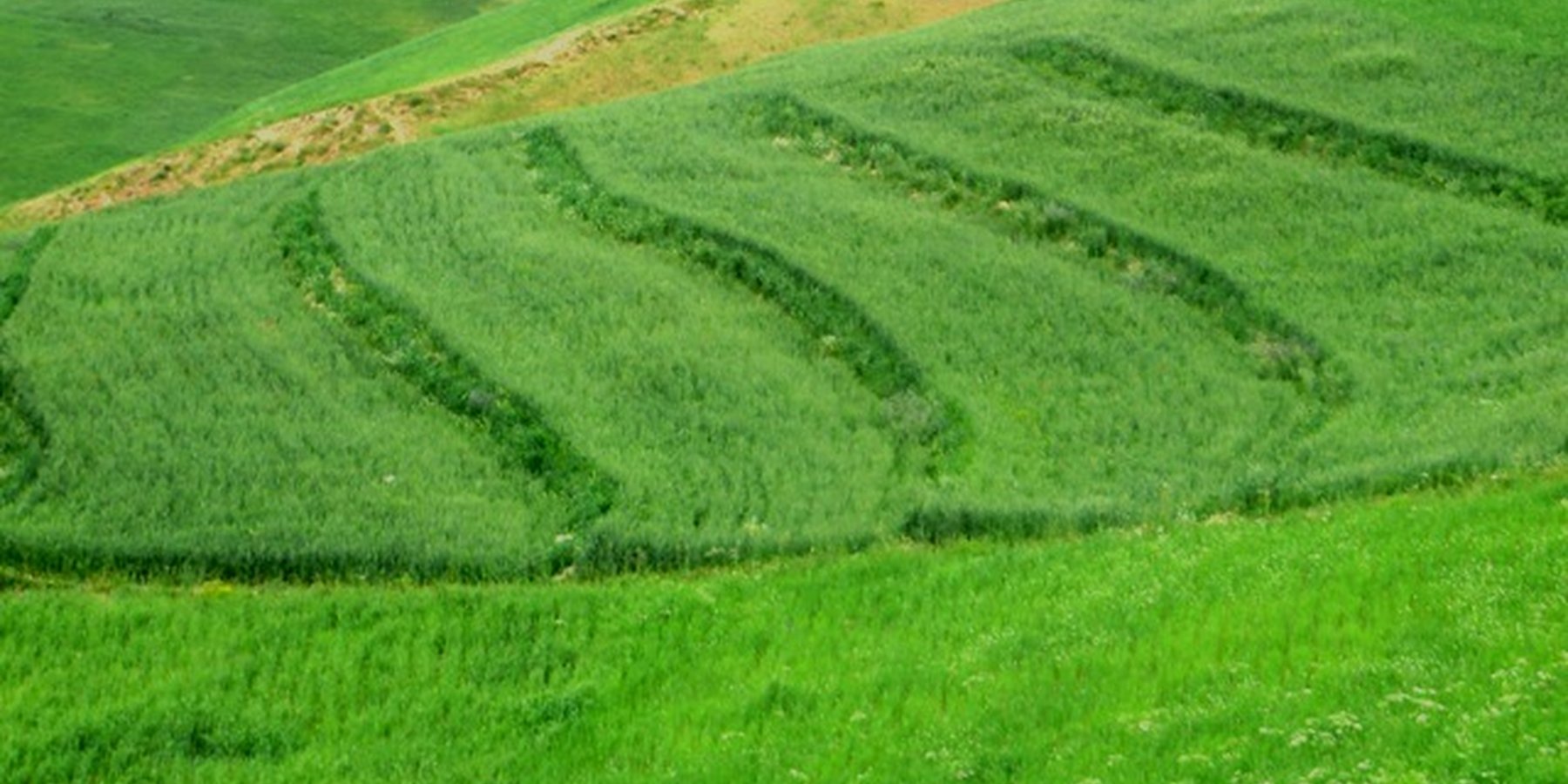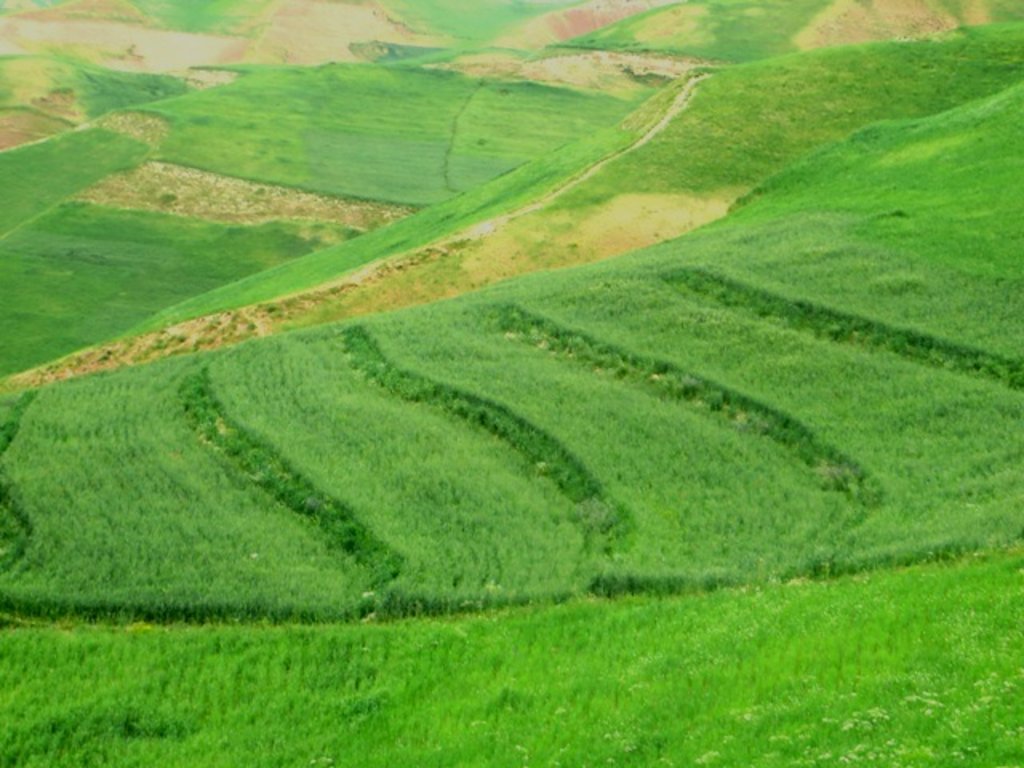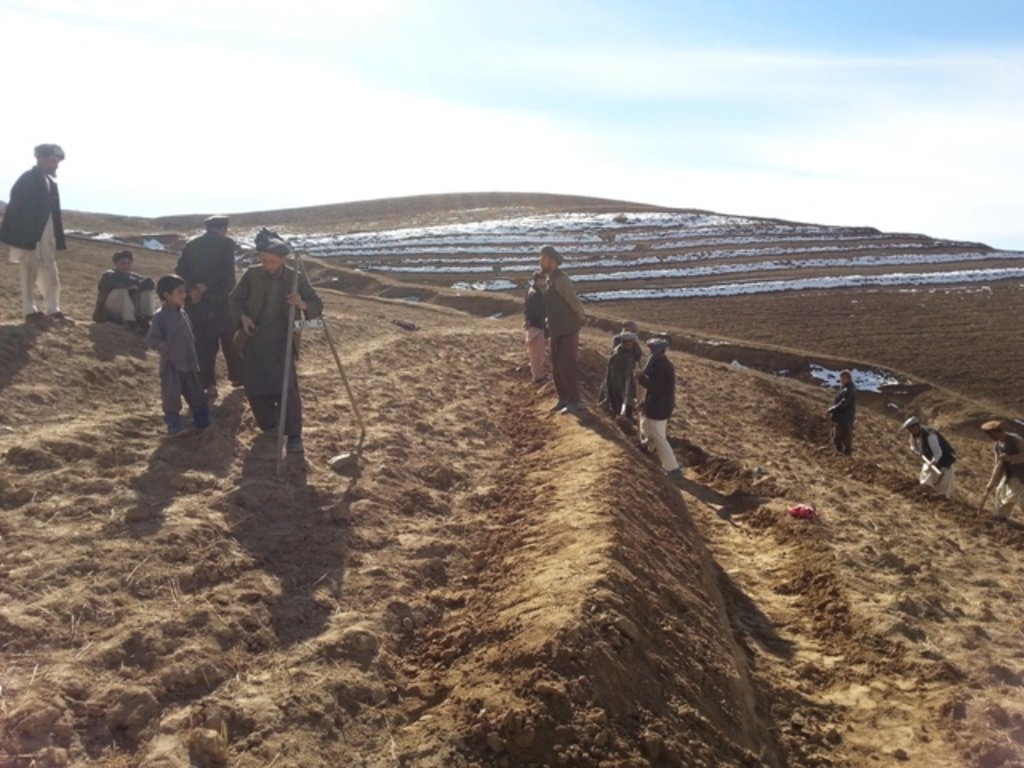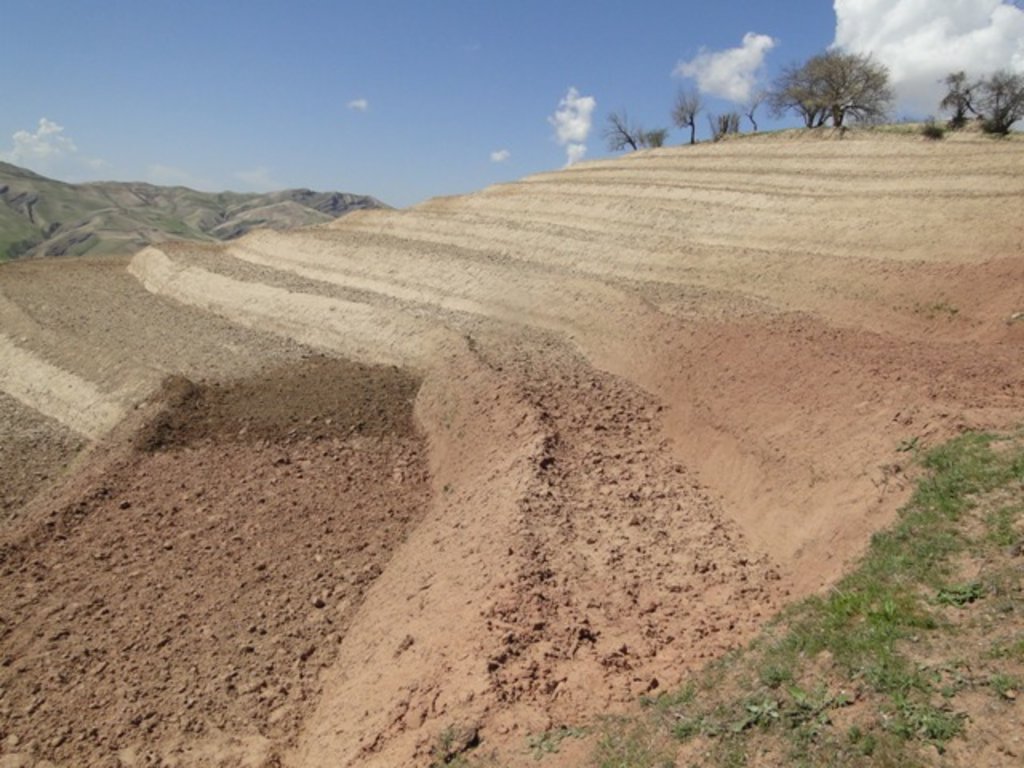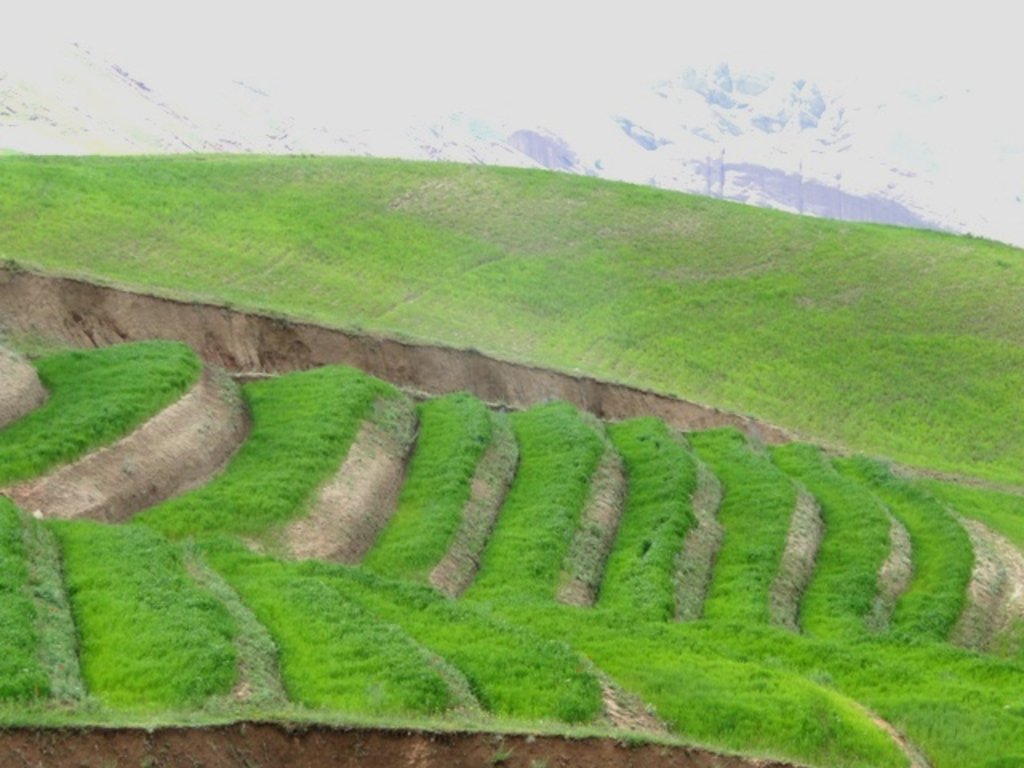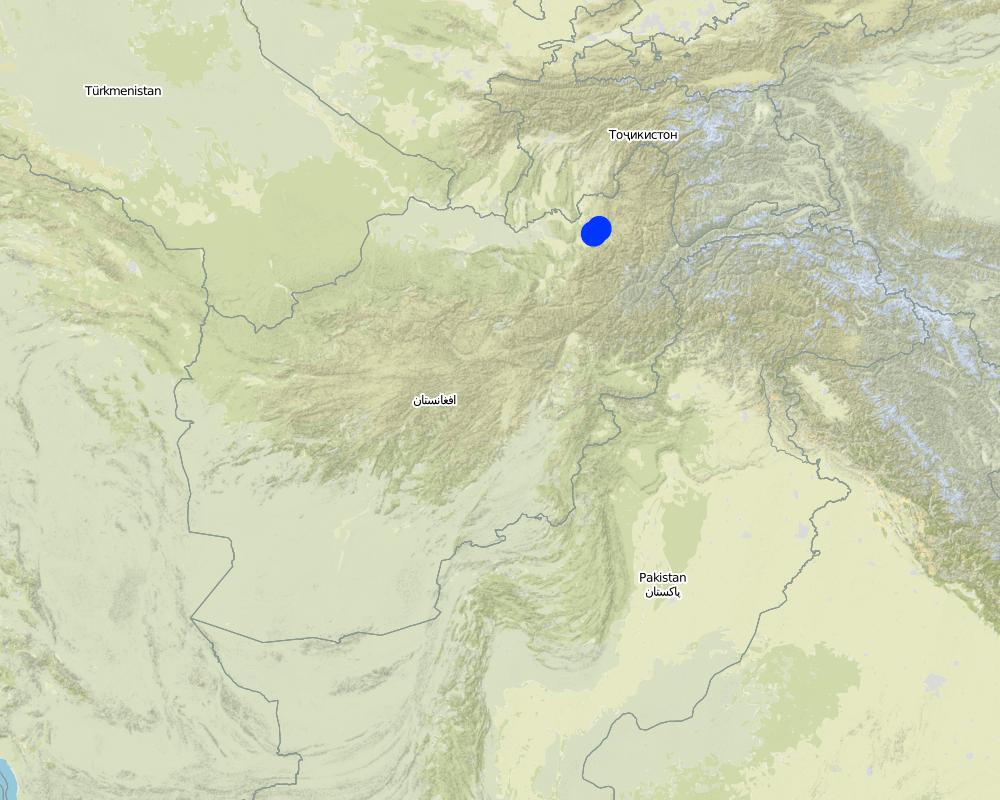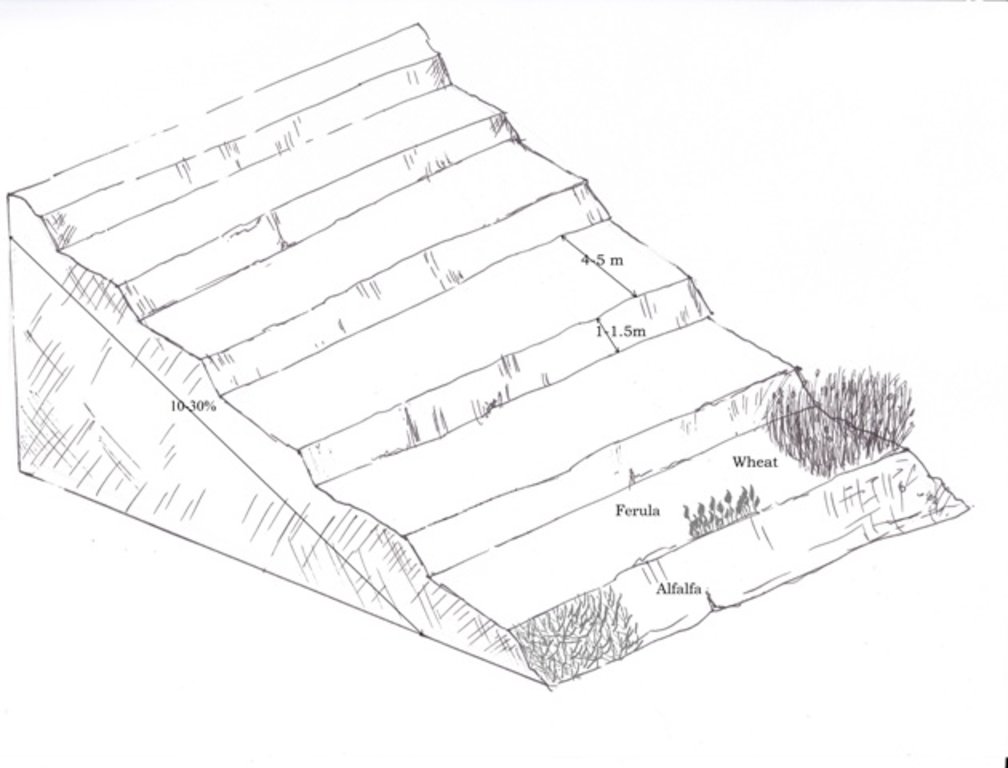Terraces with improved seed and fertilizer application [أفغانستان]
- تاريخ الإنشاء:
- تحديث:
- جامع المعلومات: Roziya Kirgizbekova
- المحرر: Bettina Wolfgramm
- المُراجع: Rima Mekdaschi Studer
Palbandi bo tukhmihoi behbudyofta va kud
technologies_607 - أفغانستان
عرض الأقسام
توسيع الكل طي الكل1. معلومات عامة
1.2 تفاصيل الاتصال بالأشخاص الرئيسيين لمصدر المعلومات والمؤسسات المشاركة في تقييم وتوثيق التقنية
الشخص (الأشخاص) الرئيسي لمصدر المعلومات
مستخدم الأرض:
Mohammad Azim Habibullah
Natural Resources Management Comittee (NRMC)
Sari Joy Village, Takhar Province
أفغانستان
متخصص في الإدارة المستدامة للأراضي:
متخصص في الإدارة المستدامة للأراضي:
Researcher:
اسم المشروع الذي سهّل توثيق/تقييم التقنية (إذا كان ذلك على صلة)
Potential and limitations for improved natural resource management (NRM) in mountain communities in the Rustaq district, Afghanistan (Rustaq NRM Study)اسم المشروع الذي سهّل توثيق/تقييم التقنية (إذا كان ذلك على صلة)
Livelihood Improvement Project Takhar, Afghanistan (LIPT)اسم المؤسسة (المؤسسات) التي سهلت توثيق/تقييم التقنية (إذا كان ذلك على صلة)
Terre des Hommes (Terre des Hommes) - سويسرااسم المؤسسة (المؤسسات) التي سهلت توثيق/تقييم التقنية (إذا كان ذلك على صلة)
Swiss Agency for Development and Cooperation (DEZA / COSUDE / DDC / SDC) - سويسرااسم المؤسسة (المؤسسات) التي سهلت توثيق/تقييم التقنية (إذا كان ذلك على صلة)
CDE Centre for Development and Environment (CDE Centre for Development and Environment) - سويسرااسم المؤسسة (المؤسسات) التي سهلت توثيق/تقييم التقنية (إذا كان ذلك على صلة)
Bern University of Applied Sciences, School of Agricultural, Forest and Food Sciences (HAFL) - سويسرا1.3 الشروط المتعلقة باستخدام البيانات الموثقة من خلال WOCAT
متى تم تجميع البيانات (ميدانيا)؟:
17/10/2016
يوافق جامع المعلومات والشخص (لاشخاص) الرئيسي لمصدر المعلومات على الشروط المتعلقة باستخدام البيانات الموثقة من خلال WOCAT:
نعم
1.4 إعلان بشأن استدامة التقنية الموصوفة
هل التقنية الموصوفة هنا تمثل مشكلة فيما يتعلق بتدهور الأراضي، بحيث لا يمكن إعلانها تقنية مستدامة لإدارة الأراضي؟:
كلا
التعليقات:
SLM practices documented in the frame of the Rustaq NRM study were established only recently (1-3 years ago). It is too early for a final judgment on the sustainability of these technologies within the human and natural environment of Chokar watershed.
1.5 الإشارة إلى الاستبيان (الاستبيانات) حول مناهج الإدارة المستدامة للأراضي
2. وصف تقنيةالإدارة المستدامي للأراضي
2.1 وصف مختصر للتقنية
تعريف التقنية:
Terraces are established on mountain slopes used mainly for cropping wheat, with the purpose of soil protection from erosion, preserving runoff, sediments and nutrients on-site. Improved seeds and fertilizer are applied on the terraces for increasing crop yield, but also vegetation cover and biomass production, and thus prevent further land degradation.
2.2 وصف تفصيلي للتقنية
الوصف:
Project supported implementation of terraces with application of improved seeds and fertilizer has taken place in the villages Sari Joy, Jawaz Khana and Dashti Mirzai, located in Chokar watershed of Rustaq District in Northern Afghanistan. The Chokar watershed is a mountainous area situated between 600 - 2,500 m above sea level. The climate is semi-arid with harsh and cold weather in winter and hot and dry summers. The annual precipitation in average years is 580mm. Land degradation affects all forms of land use and includes low vegetation cover, heavy top soil erosion from water, and poor soil fertility. Unsustainable agricultural practices, over-exploitation and high pressure on the natural resources are adversely impacting on the socio-economic well-being of local communities as well as contributing to the risk for being adversely affected by drought as well as landslides and flash floods triggered by heavy rainfall.
The data used for the documentation of the technology is based on field research conducted in Chokar watershed, namely in the villages: Sari Joy, Jawaz Khana and Dashti Mirzai. These villages represent the upper, the middle and the lower zone of Chokar watershed, respectively. They differ considerably in access to services and infrastructure, but in general are poorly served. The communities depend mainly on land resources for sustaining their livelihoods. In a good year with high yields, wheat-self-sufficiency lasts about 5 months.
Since 2012 the Livelihood Improvement Project Takhar (LIPT) implemented by Terre des hommes (Tdh) Switzerland has initiated a range of NRM interventions. The project introduced terraces as sustainable land management practices on private plots, situated on rolling (11-15%) and hilly (16-30%) slopes to protect the land from soil erosion and prevent the loss of water and fertile topsoil, seeds and fertilizers. The average plot size for terrace implementation is 2 Jerib (0.4 hectares) with contour strips of 40m x 4m. The height of the risers is 1m-1,5 m. Terrace benches are built along the contour by moving the soil above the bench downwards. The leveled benches of the terrace are cultivated with wheat. The risers of the terrace are mostly used for growing fodder crops, mostly alfalfa, which also helps to stabilize the terrace. If medicinal herbs (ferula) are included they are cultivated along the bench contours .
Maintenance activities include small repair work on the riser by adding some amount of soil and re-sowing of alfalfa seeds on those spots.
The terraces allow application of improved seeds and fertilizers without them being washed off. The land-users report noticeable increase of wheat yield from the terraced plot with application of improved seeds and fertilizer compared to the non-terraced plot. An average plot of 0.2 ha on non-terraced hilly cropland used to give about 70 kg of wheat (350kg/ha). On terraces the yield has increased/ doubled to 140 kg on the same plot area (700kg/ha). The expectations regarding terraces remain high as over the time the land user hope their land will become more stable and improved soil moisture and fertility will have positive impact on the productivity as well. However, so far no cost-benefit assessment has been conducted allowing attribution of individual measure to the wheat increase.
Many land users are interested in the terrace technology due to a number of environmental and economic benefits expected, however the costs for building the terrace are considered high by an average local land user. They have to rely on external support in order to have sufficient resources for implementation. Women considered an advantage that during the establishment phase, men were paid by the project to work on their own land (or other villagers land) when building the terraces. Thus, there was no need for men to go for seasonal labour migration and they stayed at home.
2.3 صور التقنية
2.5 البلد/المنطقة/المواقع التي تم تنفيذ التقنية فيها والتي يغطيها هذا التقييم
البلد:
أفغانستان
المنطقة/الولاية/المحافظة:
Takhar Province, Rustaq District
مزيد من التفاصيل حول الموقع:
Chokar Watershed: Sari Joy (upper watershed), Jawaz Khana (middle watershed), Dashti Mirzai (lower watershed)
التعليقات:
This documentation is based on the experiences of SLM impementers from Sari Joy (8 terraced plots), Jawaz Khana, (7 terraced plots), and Dashti Mirzai (11 terraced plots) as compiled during FGDs. The terraces located in Jawaz Khana have not been digitized yet. Additionally insights were gained through interviews in all three villages on farmers experiences and observations of terraced plots, with both SLM implementers (46) and observers (28).
Map
×2.6 تاريخ التنفيذ
في حالة عدم معرفة السنة بالتحديد، يرجى الإشارة إلى التاريخ التقريبي:
- منذ أقل من 10 سنوات (مؤخرًا)
2.7 إدخال التقنية
حدد كيف تم إدخال التقنية:
- من خلال المشاريع/ التدخلات الخارجية
التعليقات (نوع المشروع، الخ):
Livelihood Improvement Project Takhar (LIPT) supported by Swiss Development Cooperation (SDC) from 2012-17
3. تصنيف تقنية الإدارة المستدامي للأراضي
3.1 الغرض الرئيسي ( الأغراض الرئيسية) للتقنية
- تحسين الإنتاج
- الحد من تدهور الأراضي ومنعه وعكسه
3.2 نوع (أنواع) استخدام الأراضي الحالية حيث يتم تطبيق التقنية

الأراضي الزراعية
- زراعة سنوية
- زراعة معمرة (غير خشبية)
المحاصيل الرئيسية (المحاصيل النقدية والغذائية):
Wheat, Alfalfa
إذا تغير استخدام الأراضي بسبب التقنية، قم بالإشارة إلى استخدام الأرض قبل تنفيذ التقنية:
Before implementation of the Technology, only annual crops were cultivated, with wheat as the main crop. Plots were ploughed along the countours mostly by animal traction. In recent years land users are starting to use tractors for ploughing, , where villages and plots are accessible by machinery.
3.3 مزيد من المعلومات حول استخدام الأراضي
إمدادات المياه للأرض التي يتم تنفيذ التقنية عليها:
- بعلية
عدد مواسم الزراعة في السنة:
- 1
حدد:
May-July
3.4 مجموعةالإدارة المستدامة للأراضي التي تنتمي إليها هذه التقنية
- التدابير المتقاطعة للمنحدرات
3.5 انتشار التقنية
حدد انتشار التقنية:
- منتشرة بالتساوي على مساحة
إذا كانت التقنية منتشرة بالتساوي على منطقة ما، فحدد المنطقة التقريبية المغطاة:
- 0.1-1 كم2
3.6 التدابير التقنية في مجال إلادارة المستدامة للأراضي

التدابير الزراعية
- A2: المادة العضوية/خصوبة التربة

التدابير النباتية
- V2: الأعشاب والنباتات العشبية المعمرة

التدابير البنيوية
- S1: المصاطب المتدرجة
التعليقات:
Agronomic measures: Terraces increase the economic viability of applying improved seeds and (chemical) fertilizer to badly nutrient depleted cropland.
Vegetative measures: Alfalfa is planted on the risers for stabilizing the terraces, and as an important contribution to fodder cropping.
Structural measures: The leveling of countour strips allows to harvest water and sediments.
3.7 الأنواع الرئيسية من تدهور الأراضي التي تناولتها التقنية

تآكل التربة بالمياه
- الوزن(Wt): فقدان التربة السطحية/تآكل السطح
- (Wg):الانجراف الخلجاني/ الخلجان
- (Wo:) تأثيرات التدهور من مواقع أخرى

التدهور المادي أو الفيزيائي للتربة
- انسداد مسام التربة

التدهور البيولوجي
- (Bc): تناقص الغطاء النباتي
- (Bq): انخفاض الكمية/الكتلة الحيوية

تدهور المياه
3.8 منع أو حد أو عكس تدهور الأراضي
تحديد هدف التقنية فيما يتعلق بتدهور الأراضي:
- الحد من تدهور الأراضي
- اصلاح/إعادة تأهيل الأراضي المتدهورة بشدة
4. المواصفات الفنية، وأنشطة التنفيذ، والمدخلات، والتكاليف
4.1 الرسم الفني للتقنية
4.2 المواصفات الفنية/شروحات الرسم الفني
Terraces are established predominantly on a privately owned land in a mountainous landscape with varying steepness of slopes.
The average size of a plot is 2 Jerib, which is equal to 0.4 ha. The design of the terrace depends on the steepness of the slope. Mostly rolling (11-15%) and hilly (16-30%) slopes are used for building terraces.
Using an A-frame, the terrace is designed by dividing the slope into contour strips. Depending on the slope steepness, the terrace bench is around 4m wide and the the height of the risers is 1m-1,5 m. The terrace benches are built along the contour by moving the soil of upper bench to the lower bench. The leveled benches of the terrace are cultivated with wheat. The risers of the terrace are mostly used for growing fodder crops, such as alfalfa, which also helps to stabilize the terrace. If medicinal herbs are included, such as ferula, they are cultivated along the bench contours.
4.3 معلومات عامة بخصوص حساب المدخلات والتكاليف
حدد كيفية احتساب التكاليف والمدخلات:
- حسب مساحة تنفيذ التقنية
الإشارة إلى حجم ووحدة المساحة:
1 ha
حدد العملة المستخدمة لحساب التكاليف:
- دولار أمريكي
أشر إلى سعر الصرف من الدولار الأمريكي إلى العملة المحلية (إذا كان ذا صلة): 1 دولار أمريكي =:
67,0
اذكر متوسط تكلفة أجر العمالة المستأجرة في اليوم الواحد:
5.2-5.3 USD
4.4 أنشطة التأسيس
| النشاط | نوع التدبير | التوقيت | |
|---|---|---|---|
| 1. | Selection of the area for establishing a terrace (Men) | إدارية | Autumn |
| 2. | Designing of the terrace using A-frame, assisted by trained technician/project staff (Men) | بنيوية أو هيكلية | End of autumn after rainy days |
| 3. | Leveling the soil with a shovel (Men) | بنيوية أو هيكلية | Autumn/Winter |
| 4. | Sowing of alfalfa seeds on the risers (Men/women) | نباتية | After 20 days of sowing wheat |
| 5. | Sowing of wheat seeds on benches (Men/Women) | زراعية | Winter/Spring |
| 6. | Sowing of ferula along the contours (Men/women) | نباتية | Winter/Spring |
4.5 التكاليف والمدخلات اللازمة للتأسيس
| تحديد المدخلات | الوحدة | الكمية | التكاليف لكل وحدة | إجمالي التكاليف لكل مدخل | % من التكاليف التي يتحملها مستخدمو الأراضي | |
|---|---|---|---|---|---|---|
| العمالة | Designing of the terrace using A-frame | person-day | 10,0 | 9,0 | 90,0 | |
| العمالة | Leveling the soil with a shovel | person-day | 150,0 | 5,3 | 795,0 | 51,0 |
| العمالة | Sowing of wheat and alfalfa seeds | person-day | 10,0 | 5,3 | 53,0 | 51,0 |
| العمالة | Sowing of ferula | person-day | 2,0 | 5,3 | 10,6 | 100,0 |
| معدات | Pick axe | Pcs | 1,0 | 3,0 | 3,0 | 100,0 |
| معدات | Pitchfork | Pcs | 1,0 | 5,3 | 5,3 | 100,0 |
| معدات | Wheel barrow | Pcs | 1,0 | 38,0 | 38,0 | 100,0 |
| معدات | Shovel | Pcs | 1,0 | 3,8 | 3,8 | |
| معدات | Hoe | Pcs | 1,0 | 7,5 | 7,5 | |
| معدات | A-Frame | Pcs | 1,0 | 6,0 | 6,0 | |
| المواد النباتية | Wheat seeds | Kg | 140,0 | 0,42 | 58,8 | |
| المواد النباتية | Alfalfa seeds | Kg | 17,5 | 0,42 | 7,35 | 100,0 |
| المواد النباتية | Ferula seeds | Kg | 2,5 | 6,35 | 15,88 | 100,0 |
| الأسمدة والمبيدات الحيوية | DAP | Kg | 125,0 | 0,9 | 112,5 | |
| الأسمدة والمبيدات الحيوية | Urea | Kg | 125,0 | 0,45 | 56,25 | |
| الأسمدة والمبيدات الحيوية | Herbicide | Liter | 50,0 | 0,25 | 12,5 | |
| إجمالي تكاليف إنشاء التقنية | 1275,48 | |||||
إذا تحمل مستخدم الأرض أقل من 100% من التكاليف، حدد من قام بتغطية التكاليف المتبقية:
Livelihood Improvement Project Takhar (LIPT) implemented by Terre des Hommes (Tdh)
التعليقات:
Equipment provided by the project was re-used for the implemenation of different SLM practices on different plots. For completness equipment costs are fully accounted for.
Costs calculated for a Technology area of 1ha was only done for the purpose of the WOCAT documentation. In reality SLM plots are on average 0.4 ha or 2 jiribs. Costs were simply multiplied by 2.5. The actual costs for a 1ha plot might be slightly different.
4.6 الصيانة/الأنشطة المتكررة
| النشاط | نوع التدبير | التوقيت/الوتيرة | |
|---|---|---|---|
| 1. | Ploughing the land with animal traction (Men) | زراعية | Winter/Spring/Annually |
| 2. | Sowing of wheat seeds on benches (Men/Women) | زراعية | Winter/Spring/Annually |
| 3. | Application of fertilizer (Men/Women) | زراعية | Fall |
| 4. | Weeding (Women) | زراعية | Summer |
| 5. | Harvesting wheat (Men and women together) | زراعية | Summer/Fall |
| 6. | Harvesting alfalfa (Men and women together) | زراعية | Summer/Fall |
| 7. | Collecting and delivering harvested wheat (Men and women) | زراعية | Fall |
| 8. | Collecting and delivering harvested alfalfa (Men and women) | زراعية | Fall |
| 9. | Repairing terrace risers with a shovel (Men) | بنيوية أو هيكلية | Winter/Spring/After heavy rain or snow |
| 10. | Sowing alfalfa seeds on the repaired area (Men/Women) | نباتية | Winter/Spring/When required |
4.7 التكاليف والمدخلات اللازمة للصيانة/للأنشطة المتكررة (سنويًا)
| تحديد المدخلات | الوحدة | الكمية | التكاليف لكل وحدة | إجمالي التكاليف لكل مدخل | % من التكاليف التي يتحملها مستخدمو الأراضي | |
|---|---|---|---|---|---|---|
| العمالة | Ploughing the land with animal traction | person day | 2,5 | 5,3 | 13,25 | 100,0 |
| العمالة | Sowing of wheat seeds on benches | person day | 5,0 | 5,3 | 26,5 | 100,0 |
| العمالة | Weeding and Fertilizer application | person day | 5,0 | 5,3 | 26,5 | 100,0 |
| العمالة | Harvesting and delivering wheat and alfalfa | person day | 70,0 | 5,3 | 371,0 | 100,0 |
| معدات | Sickle | Pcs | 1,0 | 100,0 | ||
| المواد النباتية | Wheat seeds | Kg | 140,0 | 0,42 | 58,8 | 100,0 |
| الأسمدة والمبيدات الحيوية | DAP | Kg | 125,0 | 0,9 | 112,5 | 100,0 |
| الأسمدة والمبيدات الحيوية | Urea | Kg | 125,0 | 0,45 | 56,25 | 100,0 |
| الأسمدة والمبيدات الحيوية | Herbicide | Liter | 50,0 | 0,25 | 12,5 | 100,0 |
| إجمالي تكاليف صيانة التقنية | 677,3 | |||||
إذا تحمل مستخدم الأرض أقل من 100% من التكاليف، حدد من قام بتغطية التكاليف المتبقية:
Livelihood Improvement Project Takhar (LIPT) implemented by Terre des Hommes (Tdh)
التعليقات:
Costs calculated for a Technology area of 1ha was only done for the purpose of the WOCAT documentation. In reality SLM plots are on average 0.4 ha or 2 jiribs. Costs were simply multiplied by 2.5. The actual costs for a 1ha plot might be slightly different.
4.8 أهم العوامل المؤثرة على التكاليف
قدم وصفا لأهم العوامل التي تؤثر على التكاليف:
Due to the remoteness of the villages where the Technology has been implemented, all the inputs for establishment, such as agricultural equipment, plant material, fertilizers, etc., are purchased in Rustaq town. The expenses for traveling and delivering the inputs affect the establishment costs.
5. البيئة الطبيعية والبشرية
5.1 المناخ
هطول الأمطار السنوي
- < 250 مم
- 251- 500 ملم
- 501 - 750ملم
- 1,000-751 ملم
- 1,500-1,100 ملم
- 2,000-1,500 ملم
- 3,000-2,001 ملم
- 4,000-3,100 ملم
- > 4000 ملم
حدد متوسط هطول الأمطار السنوي (إذا كان معروفًا)، بالملليمتر:
580,00
المواصفات/التعليقات على هطول الأمطار:
Average annual precipitation for the area was calculated with 580 mm, with minimums in dry years (2000 and 2001) of 270 mm and maximums in wet years (2009/2010) of 830 mm. The absolute maximum rainfall was calculated for 1986 with 1024 mm. The data series covers the time from 1979 to 2014.
الإشارة إلى اسم محطة الأرصاد الجوية المرجعية المعنية:
Climate Forecast System Reanalysis (CFSR), http://rda.ucar.edu/pub/cfsr.html
المنطقة المناخية الزراعية
- شبه قاحلة
Specifications: Derived from the publically available dataset on length of growing period (LGP) (Fischer 2009 / IIASA-FAO). Internet link: http://tiles.arcgis.com/tiles/P8Cok4qAP1sTVE59/arcgis/rest/services/Length_of_growing_period/MapServer
5.2 طوبوغرافيا
متوسط الانحدارات:
- مسطح (0-2%)
- بسيط (3-5%)
- معتدل (6-10%)
- متدحرج (11-15%)
- تلال (16-30%)
- شديدة الانحدار(31-60%)
- فائقة الانحدار (>60%)
التضاريس:
- هضاب/سهول
- أثلام مرتفعة
- المنحدرات الجبلية
- منحدرات التلال
- منحدرات في السفوح
- قاع الوادي
المنطقة الارتفاعية:
- 100-0 متر فوق سطح البحر
- 500-101 متر فوق سطح البحر
- 1,000-501 متر فوق سطح البحر
- 1,500-1,001 متر فوق سطح البحر
- 2,000-1,501 متر فوق سطح البحر
- 2,500-2,100 متر فوق سطح البحر
- 3,000-2,501 متر فوق سطح البحر
- 4,000-3,001 متر فوق سطح البحر
- > 4000 متر فوق سطح البحر
التعليقات والمواصفات الإضافية بشأن التضاريس:
The information was derived from two different sources:
- SLM implementers information provided in the Land User Protocol (LUP) during an FGD
- Elevation and slope statistics derived for terraced plots from ASTGTM. ASTGTM is the ASTER Global Digital Elevation Model V002 with a 30 m spatial resolution. More information on ASTGTM is available here: https://lpdaac.usgs.gov/node/1079. The data can be downloaded here: https://gdex.cr.usgs.gov/gdex/
5.3 التربة
متوسط عمق التربة:
- ضحل جدًا (0-20 سم)
- ضحلة (21-50 سم)
- متوسطة العمق (51-80 سم)
- عميقة (81-120 سم)
- عميقة جدًا (> 120 سم)
قوام التربة (التربة السطحية):
- متوسط ( طميي، سلتي)
قوام التربة (> 20 سم تحت السطح):
- متوسط ( طميي، سلتي)
المواد العضوية في التربة السطحية:
- متوسطة (1-3%)
- منخفضة (<1%)
إذا كان متاحًا، قم بإرفاق وصف كامل للتربة أو تحديد المعلومات المتوفرة، على سبيل المثال نوع التربة، الرقم الهيدروجيني/ درجة حموضة التربة، قدرة التبادل الكاتيوني، النيتروجين، الملوحة وما إلى ذلك.
Local land users differentiate between the following soil types where terraces are implemented:
- Light soils: moderately deep; texture of topsoil medium (loamy, silty); low topsoil organic matter
- Dark soils: moderately deep; texture of topsoil medium (loamy, silty); medium topsoil organic matter
5.4 توافر المياه ونوعيتها
توافر المياه السطحية:
متوسط
نوعية المياه (غير المعالجة):
مياه شرب جيدة
هل تعتبر ملوحة الماء مشكلة؟:
كلا
هل تحدث فيضانات في المنطقة؟:
نعم
الإنتظام:
بشكل عرضي
تعليقات ومواصفات أخرى بشأن نوعية المياه وكميتها:
Floods occur mainly during the rainy seasons in spring and autumn. Availability of surface water differs for the three study villages Sari Joy, Jawaz Khana, and Dashti Mirzai. Sari Joy has sources and good surface water availability. Jawaz Khana has poor water availability as water has to be fetched from a lower laying stream. Dashti Mirzai has good water availability also from an irrigation channel.
5.5 التنوع البيولوجي
تنوع الأنواع:
- منخفض
تنوع الموائل:
- منخفض
5.6 خصائص مستخدمي الأراضي الذين يطبقون التقنية
مستقر أو مرتحل:
- غير المترحل
التوجه السوقي لنظام الإنتاج:
- الكفاف (الإمداد الذاتي)
- مختلط (كفاف/ تجاري)
الدخل من خارج المزرعة:
- 10-50% من جميع الإيرادات
- >50% من إجمالي الدخل
المستوى النسبي للثروة:
- متوسط
- ثري
أفراداً أو مجموعات:
- فرد/أسرة معيشية
مستوى المكننة:
- عمل يدوي
- الجر الحيواني
الجنس:
- نساء
- رجال
عمر مستخدمي الأرضي:
- متوسط العمر
- كبار السن
5.7 متوسط مساحة الأرض المملوكة أو المستأجرة من قبل مستخدمي الأراضي الذين يطبقون التقنية
- < 0.5 هكتارا
- 0.5 - 1 هكتار
- 1 -2 هكتار
- 2 - 5 هكتار
- 5 - 15 هكتار
- 15 - 50 هكتار
- 50 - 100هكتار
- 500-100 هكتار
- 1,000-500 هكتار
- 10,000-1,000 هكتار
- > 10,000 هكتار
هل يعتبر هذا نطاقًا صغيرًا أو متوسطًا أو واسعا (في إشارة إلى السياق المحلي)؟:
- على نطاق متوسط
5.8 ملكية الأراضي، وحقوق استخدام الأراضي، وحقوق استخدام المياه
ملكية الارض:
- فردية، لا يوجد سند ملكية
حقوق استخدام الأراضي:
- فردي
حقوق استخدام المياه:
- مجتمعي (منظم)
التعليقات:
Those who own land and use water for irrigation are obliged to pay for the water. The payment is made both in kind and in cash to the Mirob, the person in charge of distributing water in the community. The amount of the payment varies from village to village.
6. الآثار والتصريحات الختامية
6.1 الآثار التي أظهرتها التقنية في الموقع
الآثار الاجتماعية والاقتصادية
الإنتاج
إنتاج المحاصيل
الكمية قبل الإدارة المستدامة للأراضي:
350 kg / ha
الكمية بعد الإدارة المستدامة للأراضي:
700 kg / ha
التعليقات/ حدد:
The integration of measures including agronomic (improved seed and fertilizer) and structural (terraces to control water flow and loss of top soil, including nutrients and seeds) results in an increase of crop yield already in the first year. The effects cannot be attributed to one or the other measure specifically.
إنتاج الأعلاف
التعليقات/ حدد:
Alfalfa is planted on the risers.
تنوع المنتج
منطقة الإنتاج
التعليقات/ حدد:
No change in total area for production, as the riser of the terraces are used for fodder production. However, there is some reduction of area available for annual crop production.
الآثار الاجتماعية والثقافية
الأمن الغذائي / الاكتفاء الذاتي
التعليقات/ حدد:
The yield of the main staple crop (wheat)has been reported to be double on terraced plots with application of improved seed and fertilizer. In addition, fodder crops, such as alfalfa grown on the risers, can be harvested.
المعرفة بالإدارة المستدامة للأراضي/تدهور الأراضي
التعليقات/ حدد:
Technicians in the villages were trained in the use of A-frames. Implementers of terraces voiced that they themselves would not be able to replicated the designing of terraces.
وضع الفئات المحرومة اجتماعيا واقتصاديا
التعليقات/ حدد:
Female headed households are not included. Technology is implemented on private land, therefore people without land are excluded. However, they have the opportunity to earn income as a hired worker for the SLM implementers.
الآثار الايكولوجية
دورة المياه / الجريان السطحي
الجريان السطحي
التربة
رطوبة التربة
التعليقات/ حدد:
in situ water harvesting
فقدان التربة
التنوع البيولوجي: الغطاء النباتي، الحيوانات
الغطاء النباتي
التعليقات/ حدد:
Both an increase in vegetation cover during the growing season when most erosive rains are observed as well as permenant vegetation cover from perennial alfalfa plants can been observed.
الكتلة الحيوية/ طبقة الكربون فوق التربة
6.2 الآثار التي أظهرتها التقنية خارج الموقع
الفيضان في اتجاه مجرى النهر
تراكم الطمي باتجاه مصب النهر
القدرة على التخفيف / الترشيح
تعليقات بشأن تقييم الأثر:
These comments apply to 6.1 and 6.2:
- Socio-economic impacts: Based on the Land User Protocols: Individual SLM implementers were asked to rate the benefits for their Technology. They were asked to indicate production increase of crops; fodder; animals; wood; non-wood forest products; increase in product diversity; or production area. The most important increase they rated with 3, the second most with 2, others with 1 point. Averages of the points given by all SLM implementers are reflected here.
- Ecological impacts and off-site impacts: Based on the Land User Protocols: Individual SLM implementers were asked to rate the on-site and off-site impacts of the Technology on water; soil; and vegetation. They were asked to indicate the strength of impacts with three, two or one points. Averages of the points given by all implementers are reflected here.
6.3 تعرض التقنية وحساسيتها لتغير المناخ التدريجي والظواهر المتطرفة/الكوارث المرتبطة بالمناخ (كما يراها مستخدمو الأراضي)
الظواهر المتطرفة / الكوارث المرتبطة بالمناخ
الكوارث الجوية
| كيف تتعامل التقنية مع ذلك؟ | |
|---|---|
| عاصفة ممطرة محلية | جيدة جدا |
الكوارث المناخية
| كيف تتعامل التقنية مع ذلك؟ | |
|---|---|
| جفاف | جيدا |
التعليقات:
Based on the multi-criteria matrix: SLM implementers from three villages were asked to jointly discuss and rate how much the SLM technology reduced the lands vulnerability to drought and local rainstorms. Only vulnerability to the most prevalent climate extremes (drought and local rainstorms) was discussed. SLM technologies were rated as reducing vulnerability poorly , well, or very well. The average points reflected here are from multi-criteria matrices compiled in three villages where the SLM technology had been implemented.
6.4 تحليل التكلفة والعائد
التعليقات:
Costs: As larger parts of the establishment of the technology were covered by the project, farmers consideration of the total costs are likely underestimated.
Benefits: Two plots were terraced in 2012, and 5 plots in 2013. However, most terraces were implemented in 2014 (11 plots ) and 2015 (8 plots). The Rustaq NRM study was conducted in autumn 2016. 1-2 years of cultivating the terrace system is too short a period for providing evidence on short- and long-term returns.
6.5 اعتماد التقنية
- 1-10%
إذا كان متاحًا، قم بتحديد الكمية (عدد الأسر المعيشية و/أو المساحةالمغطاة):
10.7 ha has been terraced within the 3 study villages with LIPT project support.
من بين جميع الذين تبنوا التقنية، كم عدد الذين فعلوا ذلك بشكل تلقائي، أي دون تلقي أي حوافز مادية/مدفوعات؟:
- 10-0%
التعليقات:
Based on the Land User Protocol: Individual SLM implementers were asked whether they received support for implementing the Technology. Each indicated the type of support he received from the proposed options: "Full Support 100%, Some Support, No Support 0%". 3 implementers claimed full project support, 22 claimed some support, and 1 implementer claimed no project support.
6.6 التكيف
هل تم تعديل التقنية مؤخرًا لتتكيف مع الظروف المتغيرة؟:
نعم
إذا كانت الإجابة بنعم، وضح الظروف المتغيرة التي تم تكييفها معها:
- الأسواق المتغيرة
حدد تكيف التقنية(التصميم، المواد/الأنواع، الخ.):
Ferula is planted on the terrace in addition to wheat and alfalfa. The resin-like gum from the dried sap extracted from the stem and roots of Ferula is in high demand as a basic product for pharmaceuticals. Ferula can be sold to local merchants, who resell it to India, and is thus intercropped by some farmers on the terraces.
6.7 نقاط القوة / المزايا / الفرص التي توفرها التقنية
| نقاط القوة/ المزايا/ الفرص من وجهة نظر مستخدمي الأراضي |
|---|
| Notable higher crop yields on the plots where improved seeds and fertilizer are applied on newly established terraces. Farmers have high expectations for the years to come and for yields of annual crops (such as wheat) to remain high. |
| Diversity of crops planted on terraces is valued by the land users. For example, cultivating wheat and alfalfa on the terraced plot provides household with the key crop and also fodder for the livestock and thereby contributes to securing food for the family and maintaining better health of their cattle. Additionally, some farmers have started intercropping Ferula, a medical herb and cash crop. |
| Farmers percieve soil quality on terraced plots with fertilizer application to improve. An improvement in soil fertility (which may relate first of all to the effects of fertilizer application) and increased soil moisture have been reported. Single statements also related to effectiveness of applying fertilizer on terraced plots, as here fertilizer is not washed away during rains. |
| Terraced plots are considered less vulnerable to the effects of rainstorms and dry spells, than non-terraced plots on slopes where annual crops are cultivated. |
| Women considered an advantage that during the establishment phase, men were paid by the project to work on their own land when building the terraces. Thus, there was no need for men to go for seasonal labour migration and they stayed at home. At the same time the terracing of the land is seen as an opportunity to improve the land resources on their families plots. An increase in women's workload related to bringing food to the field during establishment was considered to be acceptable, especially compared to the expected increase in yields. |
| نقاط القوة/ المزايا/ الفرص من وجهة نظر جامع المعلومات أو غيره من الاشخاص الرئيسيين لمصدر المعلومات |
|---|
| The application of fertilizer on terraces is expected to show multiple effects: yields from these fertility depleted croplands can be increased. This includes an increase in biomass production, which may be used as green manure on the field or as animal feed or as straw. Further, vegetation cover during the growing period can be increased, which helps to protect the soil from erosive rains. |
| The project paid establishment of terraces on farmers' plots provided 20 days of employment per 2 jerib (0.4 ha) plot for farmers in their home villages. At the same time the terracing is a long-term investment into the land resources. Terracing provides an opportunity to decrease soil degradation and even to rehabilitate degraded lands. Application of improved seeds and fertilizer contribute in the establishment year to increased crop and fodder yields. |
6.8 نقاط ضعف / مساوىء / مخاطر التقنية وسبل التغلب عليها
| نقاط الضعف/ المساوىء/ المخاطر من وجهة نظر مستخدم الأراضي | كيف يمكن التغلب عليها؟ |
|---|---|
|
The implementation costs are high and land users state that it is impossible for them to cover establishment costs on their own. |
|
| Farmers expectations partly exceeded the actual yield harvested from the terraces in the first years after the implementation. | |
| Both men and women from households that have implemened terraces state that during the establishment year the household experiences an increased workload, that is not well compatible with other on-going household / farm activities. | |
| The production area for annual crops only is slighty reduced. | So far not all farmers seem to use the production area fully. Intercropping with perennial plants is recommended in order to use the risers of the terraces for fodder production. Some farmers have started intercropping of Ferula as cash crop. |
| Sufficient own land is required. | How does the amount of cropland affect the innovation readiness of a farmer? A better understanding is required on farmers willingness to take a risk for investing in a new SLM technology, and especially terracing, and influencing factors. |
| نقاط الضعف/ المساوىء/ المخاطر من وجهة نظر جامع المعلومات أو غيره من الاشخاص الرئيسيين لمصدر المعلومات | كيف يمكن التغلب عليها؟ |
|---|---|
| The technology requires technical knowledge for implementation and maintenance, which is key for successful adoption, replication and upscaling. The project trained technicians to support land users with the design of terraces. While the project aided implementation of terraces has improved the general knowledge and awareness of the land users on the benefits of SLM practices, most farmers will not be able to design terraces on their own. | |
|
Technically correct design of the terrace presents a challenge and might not be always achieved. Forward sloping terrace benches may lead to channeled runoff and have the risk of rills and gully formation. |
|
| There is an attribution gap regarding the increased wheat yields, especially with regard to individual contribution of the terraces, the application of improved seeds and the fertilizer, and the combined effects (role of terraces in making improved seed and fertilizer application effective). | A cost benefit analysis (CBA) needs to be conducted to determine short- and long-term returns of the SLM technology. On farm trials are necessary for assessing impacts of the different measures (agricultural, vegetative and structural measures) before-and-after, as well as with-without the SLM technology. |
| Terrace maintenance is crucial. If not maintained properly for a longer period of time, the damaged terrace can lead to further land degradation through channeled runoff, sever erosion and possible risks of disaster for the surrounding settlements on the slopes. | |
| The technology is established mainly by better-off households, which own more land than the average SLM implementer. |
7. المراجع والروابط
7.1 طرق جمع/مصادر المعلومات
- مقابلات مع مستخدمي الأراضي
Focus group discussions (FGD) were organized by the CDE team to collect information from SLM implementers. Total of 26 land users who have implemented terraces participated in the FGDs held in the three villages of Sari Joy, Jawaz Khana and Dashti Mirzai.
Interviews were conducted by the HAFL team to collect information from persons representing all the three study villages. Very detailed interviews were conducted with 74 persons interested in terrace implementation, of which 46 persons are from households that already have implemented terraces.
- مقابلات مع المتخصصين/الخبراء في الإدارة المستدامة للأراضي
The technical staff of Tdh LIPT Project in Rustaq, responsible for the implementation of the technology were consulted on a number of occasions during the compilation of this material.
- التجميع من التقارير والوثائق الأخرى الموجودة
Information provided in the reports of Tdh LIPT Project in Rustaq served as an initial source of information during the preparatory phase and also solidifying the description of the technology and area of implementation. Other background papers on Afghanistan were referred to for general information on agriculture and natural resource management in Afghanistan.
الروابط والوحدات المواضيعية
توسيع الكل طي الكلالروابط
لا يوجد روابط
الوحدات المواضيعية
لا يوجد وحدات مواضيعية


